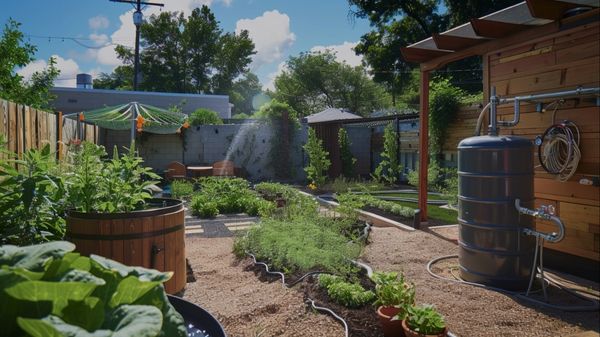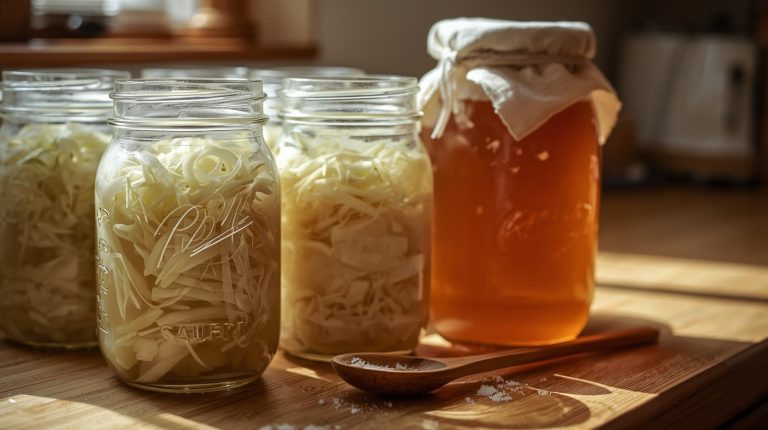To build a self-sufficient water system, start by evaluating your household’s water needs, considering daily usage and seasonal variations. Next, select an effective collection method like rainwater harvesting, guaranteeing your roof materials and gutter design are suitable for maximum efficiency.
When setting up your system, choose storage solutions that match your space and maintain optimum water quality by implementing filtration technologies, such as activated carbon or reverse osmosis, tailored to remove local contaminants. Regular maintenance guarantees system longevity and water safety. Exploring these initial steps offers a deeper understanding of adaptive methodologies for sustainable water management.
🌧️ Water Freedom for Eco-Homes
Turn Rain Into Clean, Usable Water — Naturally
The Water Freedom System gives you a simple, sustainable way to:
✔️ Harvest rainwater effortlessly
✔️ Filter it safely for home + garden use
✔️ Reduce your water bill year-round
✔️ Support a resilient, low-waste home
✔️ Stay prepared during shortages or dry seasons
Perfect for:
🌿 Plant lovers • 🌦 Tropical climates • 💧 Zero-waste homes • 🏡 Off-grid beginners
👉 Explore the Water Freedom System
https://greenlifezen.com/waterfreedom
Green Life Zen Tip: This system pairs beautifully with raised beds, indoor winter greens, and low-water gardening setups.
Key Takeaways
- Assess daily and seasonal water needs to design an effective system.
- Install a rainwater harvesting system using gutters and rain barrels.
- Choose and set up appropriate water filtration technologies like activated carbon or reverse osmosis.
- Implement storage solutions with tanks suitable for climate and space.
- Maintain the system regularly to ensure water quality and efficiency.
Assessing Your Water Needs
Before starting on creating a self-sufficient water system, it’s essential to assess your water needs accurately. Let’s dive right in—you wouldn’t want to design a system that’s thirstier than a camel in a desert marathon, would you? Incorporating techniques like rainwater harvesting or greywater recycling can help maximize efficiency.
First off, consider your daily usage. Are you watering a garden, or just trying to keep your cacti alive? Remember, sustainable gardening practices aren’t just about keeping your plants green; they’re about keeping your conscience clear too.
Think about the size of your household. More people typically means more water—unless you’re all very committed to water conservation techniques like drip irrigation, turning off the tap while brushing your teeth, or challenging each other to shorter showers. It’s not just about saving water; it’s about making every drop count like a penny-pincher at a dollar store.
Don’t forget seasonal variations. Your water needs in the sultry summer won’t be the same as in the wet winter. Planning for the peak requirement guarantees you’re never caught off-guard.
Choosing a Collection Method
To optimize your water collection, you must consider various methods tailored to your environmental conditions and spatial availability. By harvesting rainwater, you not only contribute to water conservation efforts, but also lessen reliance on municipal sources. Roof catchment techniques can efficiently harness rainwater, while integrating rain barrels enables you to store and manage runoff effectively.
The use of rainwater, free from chemicals, can enhance soil fertility and pH balance, promoting efficient gardening. Exploring groundwater recharge options further enhances your system’s sustainability by replenishing aquifers and reducing dependency on municipal sources.
Roof Catchment Techniques
When selecting a roof catchment system for rainwater collection, it’s crucial to evaluate the material and slope of your roof, as these factors greatly influence water quality and collection efficiency. Now, let’s talk gutter design and downspout placement—because who doesn’t love a bit of strategic water channeling?
First off, choosing the right gutter design isn’t just about picking the prettiest color to complement your shingles. You need a system that can handle the volume of water your roof sheds during those intense, popcorn-munching thunderstorms. A wider gutter mightn’t be as cute, but it sure does a better job at preventing overflow and the impromptu waterfall over your front door.
Then there’s downspout placement, which isn’t just a game of “pin the tail on the donkey.” You’ve got to be strategic. Position them at the corners of your house where they can do the most good, directing water away from your foundation like a well-organized exit at a rock concert.
Rain Barrel Integration
Integrating rain barrels into your water collection system is an effective strategy for maximizing rainwater reuse. Now, you’re not just saving the planet one drop at a time; you’re also giving your wallet a break from those pesky water bills. Let’s explore the nuts and bolts—or should we say, the taps and lids—of rain barrel integration.
Firstly, choosing the right rain barrel materials is essential. You’ll want something durable, like recycled plastic or cedar, which not only holds up against the elements but also adds a chic touch to your garden.
Size does matter in the world of rain barrels. Depending on your roof catchment area and local rainfall patterns, sizing can range from quaint 50-gallon barrels for the modest garden to behemoth 500-gallon tanks for the thirsty yards.
Location is key. Place your barrel under a downspout for maximum collection. Keep in mind local rain barrel legislation—some areas have guidelines on how to set these up sustainably and safely.
Don’t forget about maintenance and accessories. A mesh screen is a must to keep out debris and mosquitoes—because nobody invited them to the party. Plus, consider a spigot or a diverter to control water flow. And for the love of curb appeal, let’s make sure your rain barrel complements your garden’s aesthetics.
Groundwater Recharge Options
After maximizing surface water collection with rain barrels, you might consider delving into groundwater recharge options to further enhance your self-sufficiency. Groundwater sources aren’t just for moles and earthworms; they’re a reservoir of sustainability sitting right under your feet!
By implementing smart recharge techniques, you can contribute to aquifer management while ensuring a continuous water supply for your garden during those not-so-rainy days.
Now, let’s get technical and talk soil infiltration. This isn’t just water seeping into the ground; it’s a fine art! You’ll need to assess your soil type because clay isn’t going to be your ally here—it’s more of a stubborn gatekeeper than a welcoming host. Sandy soils, on the other hand, are like the life of the party, letting water flow through easily.
Consider constructing a recharge basin or a dry well. These are fundamentally underground storage rooms that let rainwater slowly soak into the ground, refilling aquifers rather than running off to the nearest sewer.
Just imagine—a DIY project that quenches the thirst of the earth itself!
Setting Up Rainwater Harvesting
To establish a successful rainwater harvesting system, you’ll first need to assess your regional climate and average rainfall patterns.
Let’s be honest, without rain, the only thing you’ll be harvesting is disappointment. Once you’ve nailed down the climate quirks, it’s time to choose the right rainwater harvesting methods. These can include rain barrels, roof gutter systems, and even green roofs that absorb rainwater while providing insulation and reducing energy use.
Now, it’s critical to plunge into the thrilling world of rainwater regulations. Depending on where you hang your hat, local laws might be as strict as a hall monitor or as relaxed as a retired sloth.
Next, let’s chat about the conservation benefits, because who doesn’t want to feel like an eco-warrior? Capturing rainwater reduces the demand on municipal systems, lessening your ecological footprint while potentially saving you a bundle on water bills.
It’s like giving Mother Nature a high-five with your wallet.
Setting up your system involves choosing the right catchment surface—usually a roof, unless you’ve managed to invent a rain magnet. Guttering then directs this precious agua into storage tanks.
Opt for materials that don’t leach chemicals or break the bank. Remember, a penny saved is a penny earned, especially when you’re not spending it on water. Now, get out there and turn those rainy days into resourceful opportunities!
Implementing Water Filtration
As you shift from collecting rainwater to guaranteeing its purity, selecting the right filtration method becomes critical. You’ll need to take into account the maintenance demands of different systems to assure long-term sustainability and effectiveness. Evaluating each method’s ability to remove contaminants effectively will ensure that the water you use is safe and clean.
Choosing Suitable Filtration Methods
When selecting a water filtration method for your DIY self-sufficient system, it’s crucial to assess the specific contaminants you need to remove from your water source. Here’s a breakdown of the top filtration technologies that’ll guarantee your water is as clean as a whistle (or at least as a clinically sanitized medical instrument):
1. Gravity Filters: Ideal for the lazy among us, these require no power – gravity does all the work. They’re great for removing particulates and improving taste, but don’t expect them to handle heavy metals or chemical contaminants.
2. Activated Carbon: This is your go-to if you’re fighting chemicals like chlorine or pesticides. Activated carbon absorbs impurities, guaranteeing your water doesn’t taste like you’ve just licked a swimming pool.
3. Reverse Osmosis: For the overachievers who need to strip even the smallest contaminants, reverse osmosis pushes water through a semi-permeable membrane, catching salts, bacteria, and viruses. Beware, it’s a water hog and wastes a bit.
4. UV Purification: Zap those germs away! UV purification uses ultraviolet light to kill bacteria and viruses. It’s effective, low energy, and adds no chemicals, making it a superhero in the filtration world.
Maintenance of Filtration Systems
After installing your chosen water filtration system, maintaining its efficiency is essential for ensuring long-term water safety and quality.
Let’s explore the riveting world of filtration maintenance because, let’s face it, there’s nothing more thrilling than a well-maintained filter!
First up, regular check-ups are your new best friend. Think of it as taking your pet filter to the vet. Neglect could lead to a buildup of unwanted contaminants, and nobody invited them to the party!
Make it a routine to inspect and clean your filters as recommended by the manufacturer. This isn’t just about cleanliness; it’s about water performance art.
Next, don’t forget the star of the show: filter replacement. It’s like giving your filtration system a heart transplant. Old filters can turn into breeding grounds for bacteria and reduce the effectiveness of your system, turning your clear, pristine water into a murky mystery liquid.
Set reminders to replace your filters as if your life depends on it—because, well, in a way, it does. Keeping these tips in mind, you’ll not only protect your health but also extend the life of your filtration system.
Here’s to many years of clean, safe water – cheers to that!
Ensuring Filtration Effectiveness
To guarantee your water filtration system operates at peak efficiency, you’ll need to implement a few key practices. As you immerse yourself in the world of filtration innovations, remember that keeping the humor alive can make even the most technical tasks enjoyable.
Here’s a quick rundown to make sure your system isn’t just a wet squib:
- Choose the Right Filtration Materials: Opt for materials that suit your water source. Sand mightn’t catch everything, but activated carbon might just be your new BFF for chemical filtration efficiency.
- Implement Both Biological and Chemical Filtration: Don’t put all your eggs in one basket. Use biological filtration to handle organic stuff and chemical filtration to tackle the nasties like chlorine and other fun chemicals.
- Regular Filtration Maintenance: Keep your system running smoother than a dolphin at a water slide. Regular cleaning and replacement of filters prevent performance hiccups and maintain filtration efficiency.
- Stay Updated with Filtration Technologies: Keep an eye on the latest in filtration systems and innovations. Being a geek about updates can greatly boost your system’s effectiveness without turning your life into a plumbing nightmare.
Exploring Storage Solutions
Understanding the right storage solutions is essential for maintaining a reliable water self-sufficient system. Let’s explore the nitty-gritty of choosing your tank types. Whether you’re eyeing a colossal concrete bunker or a sleek stainless steel setup, remember, size does matter, and so does material. Concrete’s great for keeping things chill, but steel’s the winner for that futuristic vibe.
Now, don’t just stack ’em and pack ’em. Space optimization is your new best friend. Think Tetris, but with water tanks. Position them cleverly to maximize your space and maintain accessibility. You’ll want easy access for maintenance, because nobody likes playing hide and seek during a system check.
Insulation options? They’re not just for your attic. Proper insulation prevents a personal pool party during winter freezes and keeps your water from turning into a sauna in the summer.
And while we’re on the subject of heat, let’s talk overflow management. Make sure your system can handle the extra flow without turning your backyard into a water theme park.
Lastly, don’t forget aesthetic considerations. Your tanks don’t have to look like a mad scientist’s lab—unless that’s your style. Blend them into your landscape to keep the neighbors happy and the HOA off your back.
Maintaining System Efficiency
With the right strategies in place, maintaining system efficiency in your DIY self-sufficient water setup isn’t just possible; it’s imperative. Let’s plunge into the nitty-gritty of keeping your system not just running, but running like a dream!
Here are four key steps to guarantee your water system remains as efficient as your initial enthusiasm:
1. Regular Checks and Balances: Just like checking your inbox for the millionth time, make it a habit to inspect your system frequently. Look out for leaks, clogs, or any sign of wear and tear. This proactive approach prevents minor issues from turning into water-wasting catastrophes.
2. Smart Water Conservation Tips: Embrace water-saving practices within your household. Turn off taps when not in use, and why not shower less? Just kidding, but maybe install water-efficient fixtures.
3. Efficiency Monitoring Tools: Invest in gadgets that can monitor water usage and efficiency. These tools are like fitness trackers but for your water system; they keep you informed and guilt-free.
4. Scheduled Maintenance: Set a calendar reminder for regular maintenance. Treat it like a dental check-up for your water system—necessary, though not always fun, but it prevents bigger headaches (or toothaches) down the line.
Expanding Your Water System
Once your system is running smoothly, you might consider expanding your self-sufficient water setup to increase capacity or integrate new technologies. Let’s face it, having more water sources than a camel has humps could be a smart move! By embracing water source diversification, you’re not just sticking to one trick, but rather, you’re becoming a hydration wizard.
Think about adding rainwater collection systems, or if you’re feeling particularly adventurous, a greywater recycling system that could make even the driest of deserts green with envy.
Next up, let’s talk about sustainable irrigation. Remember that old sprinkler system that seemed more like a random water launcher? It’s time to upgrade to something that actually considers where and when your plants need hydration. With sustainable irrigation, you’re not just throwing water willy-nilly. You’re making every drop count—like a water sniper.
Frequently Asked Questions
Can DIY Water Systems Legally Replace Municipal Water Use?
You’re diving into DIY water systems, huh? Well, before you swap city water for rain barrels, you’ve got to tackle regulatory compliance and water rights. It’s not just about hooking up some pipes and calling it a day. Every state has its own rules, and some are tighter than a rusted faucet. Don’t get soaked by legal woes—check your local laws first. It’s a drippy mess, but hey, that’s bureaucracy for you!
Are DIY Water Systems Safe for Drinking Purposes?
Ah, the age-old conundrum: can you trust DIY water systems to safely quench your thirst? Well, it boils down to water quality and the filtration methods you use. You’ve got to be a bit of a mad scientist, rigorously testing and tweaking your system to meet safety standards. Without proper filtration, you’re fundamentally playing roulette with your health.
How Does Weather Affect DIY Water System Performance?
Weather considerably impacts your DIY water system’s efficiency. Rainwater harvesting peaks with frequent showers, but you’ll need to tweak seasonal adjustments as dry spells increase evaporation rates. Filtration needs escalate with dirtier runoff during heavy rains. Meanwhile, temperature fluctuations and high humidity levels can alter water quality.
What Is the Initial Cost of a DIY Water System?
You know what they say, “You’ve got to spend money to make money.” Well, the initial cost of setting up a DIY water system might pinch your wallet, but consider it an initial investment. Depending on the complexity and size, you could be shelling out a few hundred to a couple of thousand dollars. But, hey, think of the long-term savings! It’s not just sustainable; it’s like planting a money tree in your own backyard.
Can DIY Water Systems Increase Property Value?
Absolutely, installing a DIY water system can boost your property’s value. By adding such a sustainable feature, you’re not just watering your garden but also planting seeds of property enhancement. Think of it as both an eco-friendly upgrade and a smart financial move. Potential buyers often appreciate the sustainability benefits, which can translate into a higher resale value.
Conclusion
So, you’ve mastered the art of DIY water self-sufficiency, turning mere raindrops into a personal reservoir of hydration. Feel proud as your green thumb now extends beyond your garden, straight into every drop you consume. Remember, maintaining this eco-friendly marvel requires diligence—don’t let your system turn into a backyard swamp. Keep expanding, keep refining, and who knows? Perhaps your next party trick will be sipping on a glass of crystal-clear rainwater, harvested and purified by none other than you.
🌊 Recommended Water Freedom Solution — Turn Rain into Clean, Free Water
Looking for a sustainable, off-grid way to water your garden or flush toilets without hurting the planet? The Water Freedom System offers a complete rainwater-harvesting & filtration setup, ideal for eco-homes, self-sufficient households, or anyone serious about reducing water waste.
- ✅ Harvest rainwater to use for irrigation — perfect if you care about your garden during dry periods.
- ✅ Save on water bills + reduce reliance on municipal supply.
- ✅ Eco-conscious, low-maintenance system that supports long-term sustainability.
Get the Water Freedom System here ➤
“A turnkey rainwater system that can transform how you water your garden and care for your plants — a perfect match for readers who love sustainable gardening and zero-waste living.”




